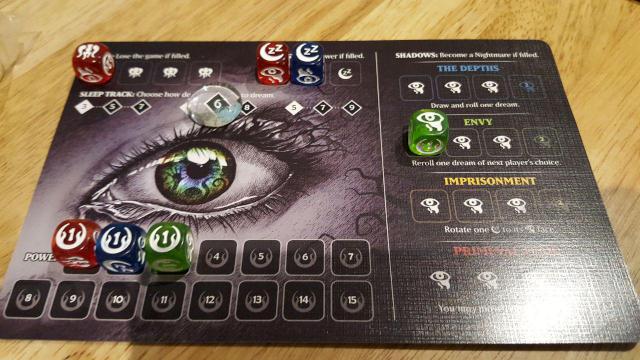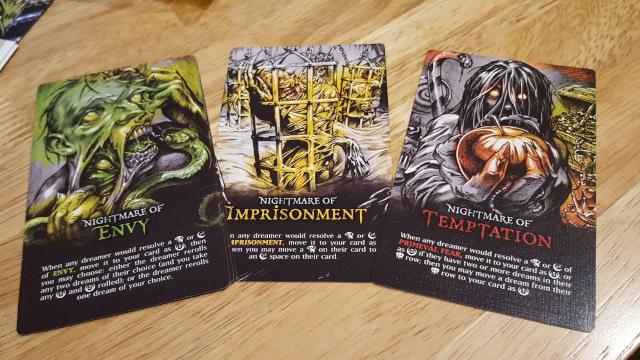
According to the ever-handy descriptions on BoardGameGeek, Lucidity: Side-Sided Nightmares “takes less than a minute to learn, and 20-30 minutes to play” which sounds pretty great when you’ve got some last minute friends coming over and don’t want to spend half the night explaining the rules of your latest game. But does that lead to a game that’s too simple to be fun? Thankfully not – Lucidity is a pretty decent game, and while there’s one big part of it that I wasn’t so keen on it’s still worth considering if you want something with a very different theme.
Lucidity is a dice-based push-your-luck game which, as with many games of this ilk, will really annoy anyone who doesn’t like the random outcomes that picking and rolling from a bag of 80 dice brings with it. You and your fellow gamers are all sleepers, trying to subconsciously wake up without turning into a nightmare first, and as such the dice you roll aren’t dice. They’re dreams. There are 4 different coloured dice, each of which carrying a different risk and reward, and as you have a small element of choice over which colours you use (you put two back in the bag after taking some) you do have an element of control over the luck that comes your way.
So let’s see if I can explain it within a minute of reading. Ready? Let’s go.

You have a Dreamer Card, as you can see above. On each turn you place your glass Sleep Marker on one of the three sleep tracks which determines how much of a risk you want to take – you can see here that I’m on the 6, so on this turn I’ll take 6 dice out of the bag. Having picked the colours I want to keep, two dice go back in the bag. Different coloured dice will push you towards different problems in the Shadows section (the right hand side of the card), with the red dice having the greatest risk of things going horribly wrong. On the flip side, the red dice also allow you to get more power (your route to winning) so there’s high risk, high reward. You can take up to three rolls per turn, with your glass marker moving up after each roll, so as you push your luck further you’re rolling more dice with a potentially higher return, but if you fill a Shadows row (entirely possible within two rolls) you’re pretty much screwed and become a nightmare. Fill up the Hunt row in the top left, and you’re totally gone. Out of the game. Finito.
Is that a minute yet? There’s more.
Knowing when to rest is key to staying in the land of the dreamers. If you fill the Exhaust row (where you can see a red and blue dice above) you stop your turn, draw a dice and remove all of your Power dice of that colour. Bummer. When you rest you can either take a Shadow dice off your card or get rid of all of your Exhaust dice, and as such a simple action of resting can be a hugely beneficial and make the difference between surviving the next turn or ending up a nightmare.
And that final point that I keep mentioning… you can become a nightmare if you fill a Shadow row, at which point you drop down to two abilities which solely exist to make life harder for the other players. You can still win the game, but it becomes a little trickier as a result of the limited moves on offer. That seems pretty intentional to me, after all the idea isn’t to turn into a nightmare if you can avoid it, but it’s nice to know hope isn’t lost when it happens.

Yeah, that wasn’t a minute. Still, that’s most of what you need to know, so pretty speedy at the very least. And on the whole, as a game, it’s really enjoyable. Turns take no time at all, so with 3 or 4 players you still won’t be hanging around long to take your next few rolls, and the push-your-luck mechanic works really nicely with the idea of going deeper into your dreams in order to build up that risk/reward idea that these games rely so strongly on. But there’s that little niggling issue… becoming a nightmare isn’t the most fun part of the game, but it can be entertaining for a while to cause chaos to other people’s games. But it’s the Hunt track that really gives this a kick; if you fill it up there’s no fall-back of the nightmare idea, you’re just out of the game and will have to wait until the entire game is done before you get back into it. That, to me, felt like a step too far, and even though the 20 minute game time is pretty accurate, it still can feel a long time when you’re sat for 10 minutes just watching the game go by. A quick house rule of this also turning you into a nightmare works nicely to avoid that, but it does put a little dent in the theme of the game.
So despite Lucidity being very decent game, two things might totally put you off: the random nature of the dice rolls, and the player elimination. But to be put off by either of those would be a shame. We enjoyed this, and while it won’t get an airing as much as other games I’m certain we’ll come back to it in the future. For something quick to learn and easy to play, it’s a very handy game to have in your collection.

Leave a Reply